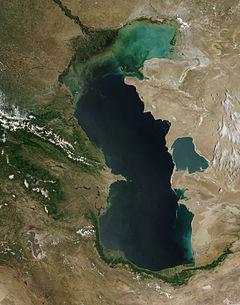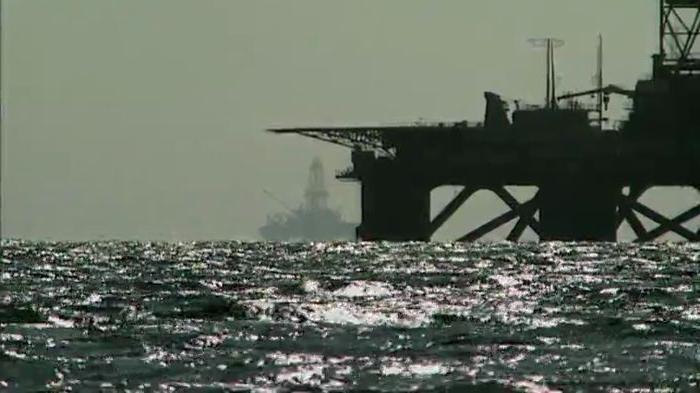There is still debate about the status of the Caspian Sea. The fact is that, despite its generally accepted name, it is nevertheless the largest drainless lake in the world. It was called the sea because of the features that the bottom structure has. It is formed by the oceanic crust. In addition, the water in the Caspian is salty. Like the sea, there are often storms and strong winds that raise high waves.
Geography
The Caspian Sea is located at the junction of Asia and Europe. In its form, it resembles one of the letters of the Latin alphabet - S. From the south to the north, the sea stretches 1200 km, and from east to west - from 195 to 435 km.
The territory of the Caspian is heterogeneous in its physical and geographical conditions. In this regard, it is conditionally divided into 3 parts. These include the North and Middle, as well as the South Caspian.
Coastal countries
What countries is washed by the Caspian Sea? There are only five of them:
- Russia, located in the northwest and west. The coastline of this state along the Caspian Sea is 695 km. Kalmykia, Dagestan and the Astrakhan region, which are part of Russia, are located here.
- Kazakhstan. This is a country on the shores of the Caspian Sea, located in the east and northeast. The length of its coastline is 2320 km.
- Turkmenistan A map of the Caspian littoral states indicates that this country is located in the southeast of the water basin. The length of the line along the coast is 1200 km.
- Azerbaijan. This state, stretching along the Caspian Sea for 955 km, washes its shores in the southwest.
- Iran. A map of the Caspian littoral states indicates that this country is located on the southern shores of a closed lake. The length of its sea borders is 724 km.
Is the Caspian Sea?
To date, no dispute has been resolved on how to name this unique body of water. And to answer this question is important. The fact is that all countries on the Caspian Sea have their own interests in this region. However, the question of how to share this huge body of water, the governments of the five states can not solve for a long time. The main controversy revolved around the name. Is the Caspian a sea or a lake? Moreover, the answer to this question is not of interest to geographers. First of all, politicians need it. This is due to the application of international law.

Caspian littoral states such as Kazakhstan and Russia believe that their borders in this region are washed by the sea. In this regard, representatives of the two countries insist on the application of the UN Convention, adopted in 1982, it concerns the law of the sea. The provisions of this document state that coastal states are allocated a twelve-mile water zone along its state borders. In addition, the country is granted the right to economic maritime territory. It is located two hundred miles away. The coastal state also has rights to the continental shelf. However, even the widest part of the Caspian is narrower than the distance specified in the international document. In this case, the midline principle can be applied. At the same time, the Caspian states, which have the greatest length of coastal borders, will receive a large sea territory.
Iran has a different opinion on this. Its representatives believe that the Caspian should be divided fairly. In this case, all countries will get twenty percent of the maritime territory. The position of official Tehran can be understood. With this solution to the problem, the state will manage a larger zone than when dividing the sea along the midline.
However, the Caspian Sea significantly changes its water level from year to year. This does not allow us to determine its middle line and divide the territory between states. Countries of the Caspian Sea, such as Azerbaijan, Kazakhstan and Russia, have signed an agreement among themselves, defining those bottom zones in which the parties will exercise their economic rights. Thus, a certain legal cease-fire was reached in the northern territories of the sea. The southern countries of the Caspian Sea have not yet come to a single decision. However, they do not recognize the agreements reached by the northern neighbors.
Is the Caspian a lake?
Adherents of this point of view proceed from the fact that the reservoir located at the junction of Asia and Europe is closed. In this case, it is impossible to apply a document on the norms of international law of the sea to it. Proponents of this theory are convinced that they are right, referring to the fact that the Caspian has no natural connection with the waters of the oceans. But here is another difficulty. If the lake is the Caspian Sea, according to what international standards, should the borders of states be defined on its open spaces? Unfortunately, such documents have not yet been developed. The fact is that the issues of the international lake were not discussed anywhere.
Is the Caspian a unique reservoir?
In addition to the above, there is another, third point of view on the belonging of this amazing reservoir. Its supporters are of the opinion that the Caspian should be recognized as an international water basin that belongs equally to all the countries bordering it. In their opinion, the region’s resources are subject to joint exploitation by countries bordering the water body.
Security Solution
The Caspian littoral states are doing everything possible to resolve all existing differences. And in this matter, positive developments can be noted. One of the steps towards resolving problems related to the Caspian region was the agreement signed on November 18, 2010 between all five countries. It relates to security cooperation. In this document, the countries agreed on joint activities to eliminate terrorism, drug trafficking, smuggling, poaching, laundering of illegal proceeds in the region, etc.
Environmental protection
Particular attention is paid to solving environmental issues. The territory on which the Caspian littoral states and Eurasia are located is a region threatened by industrial pollution. Kazakhstan, Turkmenistan, and Azerbaijan dump waste from the exploration and production of energy carriers into the waters of the Caspian Sea. Moreover, it is precisely in these countries that a large number of abandoned oil wells are located that are not exploited due to their unprofitability, but nevertheless continue to have an adverse effect on the environmental situation. As for Iran, it dumps agricultural waste and sewage into the sea waters. Russia threatens the ecology of the region with industrial pollution. This is due to economic activity unfolding in the Volga region.

Countries on the Caspian Sea have made some progress in resolving environmental problems. So, from 08/12/2007 in the region the Framework convection has been in force, setting itself the goal of protecting the Caspian Sea. This document has developed provisions on the protection of biological resources and the regulation of anthropogenic factors affecting the aquatic environment. According to this convection, the parties should cooperate in carrying out measures to improve the environmental situation in the Caspian.
In 2011 and 2012, all five countries signed other documents significant for the protection of the marine environment. Among them:
- Protocol on cooperation, response and regional preparedness in cases of oil pollution.
- Protocol Relating to the Protection of the Region from Pollution from Ground-Based Sources.
Gas pipeline construction development
Today, another problem is unresolved in the Caspian region. It concerns the laying of the Nabucco gas pipeline. This idea is an important strategic task of the West and the USA, which continue to search for energy sources alternative to Russian. That is why when solving this issue, the parties do not turn to countries such as Kazakhstan, Iran and, of course, the Russian Federation. Brussels and Washington supported the statement of the President of Turkmenistan made in Baku on 11/18/2010 at the summit of the heads of the Caspian littoral countries. He expressed the official position of Ashgabat regarding the laying of the pipeline. Turkmen authorities believe that the project should be implemented. At the same time, only those states should give their consent to the construction of the pipeline, on whose bottom territories it will be located. And this is Turkmenistan and Azerbaijan. Iran and Russia opposed such a position and the project itself. Moreover, they were guided by the issues of protecting the Caspian ecosystem. To date, the construction of the pipeline is not carried out due to the disagreement of the project participants.
First Summit
Countries on the Caspian Sea are constantly looking for ways to solve the problems that have matured in this Eurasian region. For this, special meetings of their representatives are organized. So, the first summit of the heads of the Caspian littoral states took place in April 2002. Ashgabat was the venue for it. However, the results of this meeting did not meet expectations. The summit was declared unsuccessful due to Iran's requirements for dividing the sea into 5 equal parts. Other countries categorically opposed this. Their representatives defended their own point of view that the size of national water areas should correspond to the length that the coastline of the state has.

The unsuccessful summit provoked a dispute between Ashgabat and Baku on the ownership of three oil fields located in the center of the Caspian Sea. As a result, the heads of five states did not develop a unified opinion on any of the issues that were raised. However, at the same time, they concluded an agreement on holding a second summit. It was supposed to be held in 2003 in Baku.
Second Caspian Summit
Despite the existing agreements, the holding of the scheduled meeting was postponed annually. The heads of the Caspian littoral states gathered for the second summit only on October 16, 2007. Tehran became the venue for it. The meeting discussed current issues related to determining the legal status of a unique reservoir, which is the Caspian Sea. The borders of the states within the framework of the section of the water area were previously agreed upon in the development of the draft new convention. The problems of security, ecology, economics and cooperation of coastal countries were also raised. In addition, the results of the work carried out by the states after the first summit were summed up. In Tehran, representatives of five states also outlined the ways for further cooperation in the region.
Meeting at the third summit
Once again, the leaders of the Caspian littoral countries met in Baku on November 18, 2010. The result of this summit was the signing of an agreement to expand cooperation on security issues. During the meeting, it was pointed out that which countries were washed by the Caspian Sea, only those should ensure the fight against terrorism, transnational crime, the proliferation of weapons, etc.
Fourth summit
Once again, the littoral states raised their problems in Astrakhan on September 29, 2014. At this meeting, the presidents of the five countries signed another statement.
In it, the parties recorded the exclusive right of the coastal countries to deploy armed forces in the Caspian. But even at this meeting, the status of the Caspian was not finally regulated.